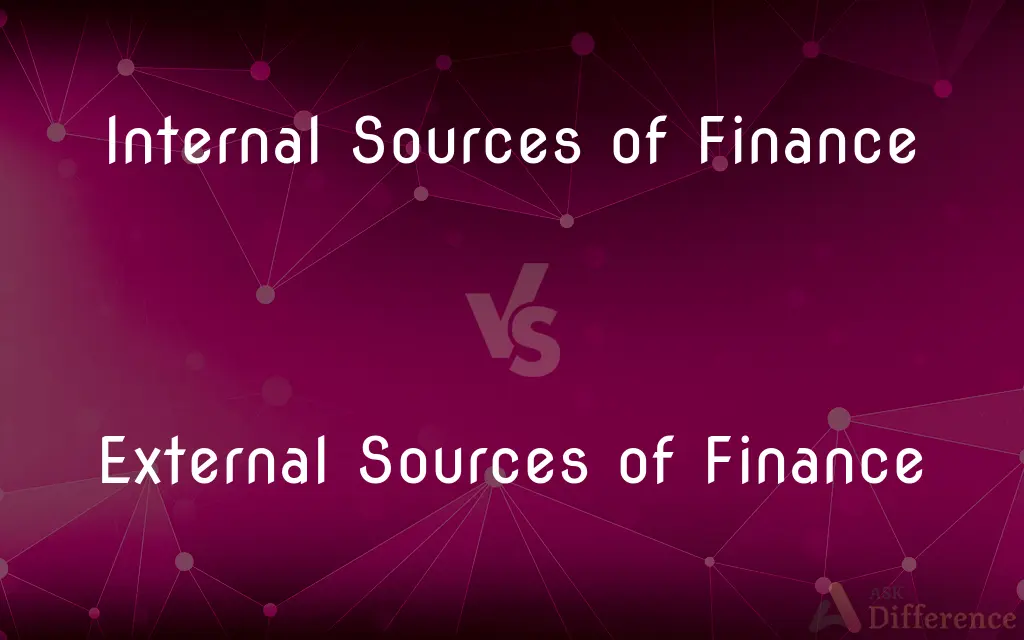Internal Sources of Finance vs. External Sources of Finance — What's the Difference?
Edited by Tayyaba Rehman — By Fiza Rafique — Published on December 14, 2023
Internal Sources of Finance are funds generated within a business, while External Sources of Finance are funds obtained outside the business.

Difference Between Internal Sources of Finance and External Sources of Finance
Table of Contents
ADVERTISEMENT
Key Differences
Internal Sources of Finance refer to the funds that a business generates from its operations or as a part of its existing assets. This can be through retained earnings, depreciation funds, or the sale of existing assets. Such sources are usually under the direct control of the business and often don't involve additional costs like interest. They signify a business's ability to self-finance or bootstrap.
External Sources of Finance, on the other hand, involve obtaining funds from outside the business. This can be in the form of bank loans, issuing shares, bonds, or seeking venture capital. These sources generally come with costs, such as interest on loans or dividends on shares. Relying on external financing may indicate a company's ambition to grow or the need for significant capital expenditure.
Internal Sources of Finance can be considered more readily available since they don't require negotiations with external entities or lengthy approval processes. They can be used to maintain a company's operations or to fund smaller projects without creating additional liabilities.
External Sources of Finance often provide larger amounts of capital suitable for expansion, significant projects, or when internal funds are inadequate. They may, however, subject a company to external scrutiny and conditions, such as maintaining specific financial ratios or providing periodic financial reports.
Finally, while Internal Sources of Finance usually have no additional financial cost to the company, External Sources of Finance come with strings attached, such as interest payments or equity dilution.
ADVERTISEMENT
Comparison Chart
Part of Speech
Noun (Plural)
Noun (Plural)
Use in Compound Sentences
"The company relied on Internal Sources of Finance to fund the new project, but when it expanded globally, it looked for External Sources of Finance."
As mentioned earlier
Dependent Prepositions
"From Internal Sources of Finance"
"Through External Sources of Finance"
Common Adjectives Describing Them
"Own, generated, existing"
"Borrowed, external, third-party"
Presence of External Agents or Stakeholders
None
Often involved, e.g., banks, investors
Compare with Definitions
Internal Sources of Finance
Capital obtained from the sale of a business's non-core assets.
By selling off some of its old machinery, the firm bolstered its Internal Sources of Finance.
External Sources of Finance
Loans acquired from financial institutions.
The company's expansion was majorly funded through External Sources of Finance, including a significant bank loan.
Internal Sources of Finance
Funds generated from a company's own operations or assets.
The startup used its Internal Sources of Finance from initial sales to develop a new product.
External Sources of Finance
Capital raised from outside entities such as banks or investors.
To open new stores across the country, they sought External Sources of Finance.
Internal Sources of Finance
Resources derived from a company's savings or reserves.
The company's strong Internal Sources of Finance allowed it to weather economic downturns without external borrowing.
External Sources of Finance
Financing secured through venture capital or angel investors.
The tech startup thrived with External Sources of Finance from a prominent venture capitalist.
Internal Sources of Finance
Finance derived from the reduction of working capital or fixed assets.
The business shifted some inventory, adding to its Internal Sources of Finance for the new project.
External Sources of Finance
Monies sourced from trade credit or advances from customers.
By negotiating favorable terms with suppliers, the business leveraged External Sources of Finance to manage its cash flow.
Internal Sources of Finance
Accumulated profits that a company reinvests.
Rather than paying out dividends, they decided to use Internal Sources of Finance to expand their facilities.
External Sources of Finance
Funds obtained by issuing shares, bonds, or securities.
Their External Sources of Finance included a successful bond issuance last quarter.
Common Curiosities
How do External Sources of Finance differ?
They involve obtaining funds from outside the business, like loans or issuing shares.
Why might a company seek External Sources of Finance?
For larger capital needs, expansion, or when internal funds are insufficient.
Can Internal Sources of Finance be considered safer?
Generally, yes, as they don't create additional liabilities like interest.
Are Internal Sources of Finance always available?
Not necessarily; it depends on the company's financial health and profitability.
What are Internal Sources of Finance?
They are funds generated within a business, like retained earnings or sale of assets.
Are there costs associated with External Sources of Finance?
Yes, often in the form of interest, fees, or equity dilution.
Can the sale of a business asset be considered an Internal Source of Finance?
Yes, as it generates funds from existing assets.
Can trade credits be seen as External Sources of Finance?
Yes, as they involve external entities providing finance in the form of deferred payments.
What's a common External Sources of Finance for startups?
Venture capital or angel investment.
Is depreciation a form of Internal Sources of Finance?
Yes, as it provides funds internally by accounting for asset wear and tear.
Do Internal Sources of Finance dilute company ownership?
No, they come from within the business and don't affect ownership.
Between Internal Sources of Finance and External Sources of Finance, which is more flexible?
Internal sources are often more flexible, but external sources can offer larger funds.
How quickly can Internal Sources of Finance be accessed?
Usually faster than external sources, as there's no need for external approvals.
Are bonds considered External Sources of Finance?
Yes, as they involve raising capital from external investors.
What risks come with External Sources of Finance?
Debt obligations, loss of equity, and external control or scrutiny.
Share Your Discovery

Previous Comparison
Cardiac Skeletal vs. Smooth Muscle
Next Comparison
Coral Snake vs. King SnakeAuthor Spotlight
Written by
Fiza RafiqueFiza Rafique is a skilled content writer at AskDifference.com, where she meticulously refines and enhances written pieces. Drawing from her vast editorial expertise, Fiza ensures clarity, accuracy, and precision in every article. Passionate about language, she continually seeks to elevate the quality of content for readers worldwide.
Edited by
Tayyaba RehmanTayyaba Rehman is a distinguished writer, currently serving as a primary contributor to askdifference.com. As a researcher in semantics and etymology, Tayyaba's passion for the complexity of languages and their distinctions has found a perfect home on the platform. Tayyaba delves into the intricacies of language, distinguishing between commonly confused words and phrases, thereby providing clarity for readers worldwide.












































